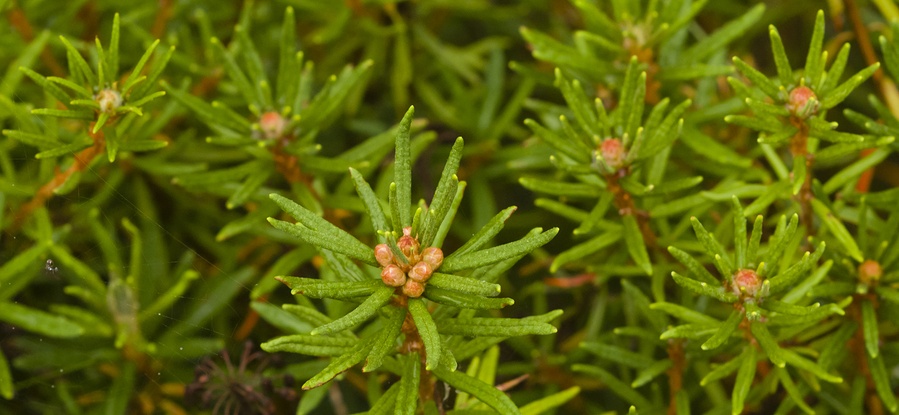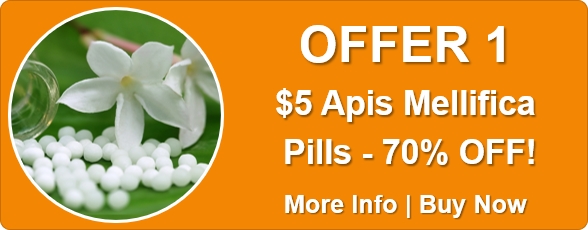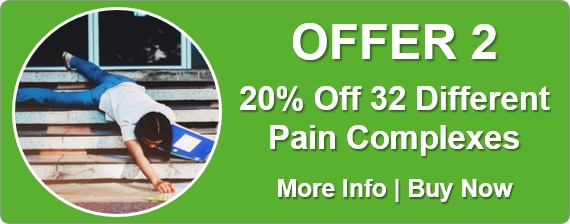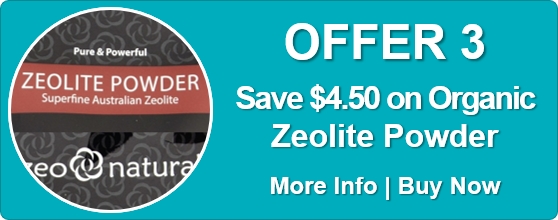Know Your Remedies: Ledum Palustre (Led.)
 Common Names: Ledum; marsh Labrador tea; wild rosemary.
Common Names: Ledum; marsh Labrador tea; wild rosemary.
General Information
Ledum Palustre (Led.) is an important remedy for puncture wounds from stings, bites, nail or thorn penetration. The affected area swells, feels cold to touch, and is mottled or bluish. It also suits joint swelling, pain or gout that is better for cold applications (even ice) and worsened by warmth. Those needing Ledum often dislike company and want to be alone.
Bites and Stings
- Animal, insect, or tick bites and stings that become cold, puffy and mottled.
Injuries
- Pain from puncture wounds (such as nails in sole of foot) or cuts to hands and feet which are relieved by cold compresses and worsened by warmth.
- Septic states of wounds with swelling, mottling and coldness.
Joint Problems
- Person may feel cold but cold applications relieve joint pains while warmth aggravates them.
- Pain and stiffness in joints – better for cold applications and worse for warmth.
- Rheumatism or pain starts in the small joints of lower limbs and moves upwards.
- Rheumatism worsened by getting warm in bed.
- Gout, especially of feet and knees, relieved by cold.
- Sprains of joints, especially ankles.
- Itching of feet and ankles.
Eye Problems
- Black eye – pain in eyeball relieved by cold compresses.
For Pets
- Puncture wounds.
- Bites from fights.
Where do I find it?
Ledum Palustre (Led.) is available from our online store as a single remedy, and as part of the following Complexes (combination remedies): Bites and Stings; Joints – Stiff.
Home Treatment Guidelines
Acute, Self-Limiting Conditions
Conditions like colds or minor injuries, which are short-term and typically improve on their own, can be managed at home with homeopathy. However, in emergencies or if symptoms worsen, contact your healthcare provider.
Chronic Conditions
These home treatment instructions do not apply for ongoing issues, whether mentioned above or not, like persistent allergies or chronic pain. You should consult a qualified homeopath for a personalized treatment plan to achieve the best results with homeopathy for chronic conditions.
How to Take the Remedy for Acute Conditions
- Take one pill or five drops of the remedy. The frequency depends on symptom severity. As examples:
- For life-threatening symptoms, take every 1 minute and seek emergency help immediately.
- For mild symptoms, take every 4 hours.
- Stop taking the remedy once you feel better. Resume if symptoms return.
- If no improvement after four doses, choose a different remedy or consult a professional homeopath.
- For more details on dosing, refer to: How Often to Dose with a 30C Homeopathic remedy.
- For information on the different potencies, read: Guidelines on which potency to use
Additional Notes From Past Masters
Homeopathy is a 200-year-old system of medicine. Early homeopaths recorded detailed notes on how remedies worked, including initial tests, remedy relationships, and their experiences. These writings were shared to improve homeopathic practice and now offer fascinating insights into past uses of homeopathy. Here’s an example, edited and modernised for clarity, from Leaders In Homoeopathic Therapeutics (1898) by E. B. NASH M.D.:
Leaders In Homoeopathic Therapeutics by E. B. NASH M.D.
Ledum palustre
Rheumatism begins in feet and travels upward (Kalmia opposite).
The swellings are pale, sometimes edematous, and < at night, in the heat of the bed; uncovering or cold water relieves.
Ecchymosis; “black eye” from a blow or contusion; better than Arnica.
Rheumatism and rheumatic gout; joints become the seat of nodosities and “gout stones,” which are painful.
Complaints of people who are cold all the time; lack of animal or vital heat; parts cold to touch, but not cold subjectively to patient.
Punctured wounds by sharp-pointed instruments, rat bites, stings of insects, especially mosquitoes.
Ledum is a very valuable remedy for rheumatism.
This complaint is confessedly a very difficult disease to cure by old school treatment. Seldom is a case of the inflammatory form completely cured by them. The great majority of their cases run from the acute into the chronic form, and last for life. They are often drawn all out of shape (their patients), or left with incurable valvular heart trouble.
This is not the case under homoeopathic treatment. On the contrary the patients treated homoeopathically are generally cured, and very seldom left with any heart trouble, even if the disease commenced there, as it sometimes does.
Oftener, of course, it begins in the back, extremities or joints generally, and then if treated allopathically with local applications it is driven to the heart, which cannot be reached with local applications, hence stays there until exudations occur and hardened deposits from upon the valves.
Any homoeopathic physician guilty of treating a case this way, with such results, ought to lose his practice and his diploma.
I do not say this inadvisedly, for I have lived and practiced for thirty years past in a decidedly rheumatic district and know whereof I affirm.
When we homoeopaths of the East condemn those of the West for the Quinine (in material doses) treatment of intermittents, we are reminded that we do not live in miasmatic districts so we are not authority and we can only reply that we know many physicians who do live there who cure their patients without the abuse of Quinine.
But in this verdict of mine on rheumatism I cannot be turned off that way. Rheumatism is one of those diseases that presents plenty of symptoms and modalities to guide to the choice from a long list of remedies of the one appropriate to the case in hand.
There is such a great difference in the results of applying the remedy according to symptomatic indications, and those arising from simply pathological prescribing, that one does not need long to experiment to be convinced. Indeed the pathological condition in this complaint does not figure largely in the account, for purposes of prescribing. But sensations and modalities do.
The Ledum rheumatism begins in the feet and travels upward. This is the opposite of Kalmia, which goes the other way.
Ledum may be indicated in both acute and chronic forms of this complaint.
In the acute form the joints are swollen and hot, but not red. The swellings are pale and the pains are worse at night and from the heat of the bed, wants them uncovered. This is like Mercurius, but with Mercury the profuse sweat without relief, and especially the characteristic mouth and tongue symptoms will decide. I have seen wonderful benefit from Ledum in such cases.
In the chronic form of the disease this remedy is equally efficacious. Here also we have the joints swollen and painful, especially in the heat of the bed, and painful, hard nodes and concretions form in the joints of feet first, then hands.
The periosteum of the phalanges is painful on pressure. The ankles are swollen and the soles are painful and sensitive, can hardly step on them. This painful and sensitive soles of feet is also found under Antimonium crud., Lycopodium and Silicea, and I have relieved it, other symptoms agreeing, with each and every one of these remedies.
In these case of rheumatic troubles the Ledum patient is unnaturally cold. “Lacks vital or animal heat,” in this, again, resembling Silicea; but although the Silicea patient has chronic rheumatism of the feet, ankles and soles similar to Ledum, aggravated also at night, the warmth of the bed does not aggravate, but on the contrary he wants to be covered warmly.
Under Ledum the relief from cold is so prominent that sometimes the only amelioration is from putting the feet into cold water. It is well to think of Ledum in all cases of rheumatism of the feet and study it up.
We must not leave this remedy without calling attention to its virtues as a remedy for injuries.
We are apt to think of Arnica first, for bruises and the results therefrom, and, on account of its well deserved reputation, to forget that there are sometimes other remedies equally valuable.
Ledum sometimes comes in to finish up a work that Arnica began well, but could not complete, even when Arnica was best at first, for it often removes the ecchymosis and discoloration more rapidly and perfectly. For black and blue spots from blows or bruises there is no better remedy than Ledum.
Then, again, we have Sulphuric acid, which is very useful in ecchymosis from the same cause, especially if occurring in cachectic or weakened constitutions, with tendency to purpura, or breaking down of the blood. This pathological condition would be attended with the characteristic symptoms of the drug.
We often have ecchymosis into the conjunctiva or sclerotica, for which Nux vomica is specific, but for “black eye” from a blow of the fist no remedy equals Ledum in the 2c potency.
Ledum is a good remedy for punctured wounds, such as the sticking of a nail into the foot, or an awl into the hand, etc.; also for stings of insects, especially mosquitoes, but this also needs modification.
It makes some difference what kind of tissue is wounded by this kind of wound If a nerve, for instance, Hypericum would be preferable; if the periosteum, Ruta; if the bone, Calcarea phos., or Symphytum to promote re-union or repair.
We must not forget to mention in connection with what has been said of Ledum in injuries of the eye that if there is great pain in the eyeball itself from the blow, Symphytum may have to be used. For all these affections I believe the 200th potency better than the lower preparations.







